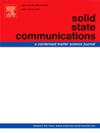反应溅射生长超薄HfO2薄膜的电学和结构均匀性研究
IF 2.1
4区 物理与天体物理
Q3 PHYSICS, CONDENSED MATTER
引用次数: 0
摘要
HfO2经常用于开发各种需要高质量超薄绝缘层的微电子器件。在这项工作中,我们使用导电隧道原子力显微镜(TUNA)研究了室温下在超导氮化钼电极上反应溅射生长的超薄HfO2薄膜的绝缘性能,并将其沉积在(100)硅片上。结果表明,制备的HfO2层均匀且具有良好的绝缘性能,即使在0.5 nm的厚度上也没有针孔。室温下基于tuna的电流电压测量表明,载流子衰减长度为0.13 nm,估计能隙为2.8 eV。层的厚度分布宽度很低(~ 0.06 nm),与低表面粗糙度(<0.2 nm)一致。这些结果证实了室温沉积HfO2的坚固绝缘性能,使其成为开发微电子器件的非常合适的材料。本文章由计算机程序翻译,如有差异,请以英文原文为准。
Study of the electrical and structural homogeneity of ultrathin HfO2 films grown by reactive sputtering
HfO2 is often used in the development of various microelectronic devices requiring high-quality ultrathin insulating layers. In this work, we used conductive Tunneling Atomic Force Microscopy (TUNA) to study the insulating properties of ultra-thin HfO2 films grown at room temperature on superconducting molybdenum nitride electrodes by reactive sputtering, deposited on (100) silicon wafers. The results indicate that the HfO2 layers are homogeneous and exhibit excellent insulating properties, with no pinholes even at a thickness of 0.5 nm. TUNA-based current-voltage measurements at room temperature indicate a charge carrier attenuation length of 0.13 nm and an estimated energy gap of 2.8 eV. The thickness distribution width of the layers is very low (∼0.06 nm), consistent with a low surface roughness (<0.2 nm). These results confirm the robust insulating properties of room-temperature-deposited HfO2, making it a highly suitable material for the development of microelectronics devices.
求助全文
通过发布文献求助,成功后即可免费获取论文全文。
去求助
来源期刊

Solid State Communications
物理-物理:凝聚态物理
CiteScore
3.40
自引率
4.80%
发文量
287
审稿时长
51 days
期刊介绍:
Solid State Communications is an international medium for the publication of short communications and original research articles on significant developments in condensed matter science, giving scientists immediate access to important, recently completed work. The journal publishes original experimental and theoretical research on the physical and chemical properties of solids and other condensed systems and also on their preparation. The submission of manuscripts reporting research on the basic physics of materials science and devices, as well as of state-of-the-art microstructures and nanostructures, is encouraged.
A coherent quantitative treatment emphasizing new physics is expected rather than a simple accumulation of experimental data. Consistent with these aims, the short communications should be kept concise and short, usually not longer than six printed pages. The number of figures and tables should also be kept to a minimum. Solid State Communications now also welcomes original research articles without length restrictions.
The Fast-Track section of Solid State Communications is the venue for very rapid publication of short communications on significant developments in condensed matter science. The goal is to offer the broad condensed matter community quick and immediate access to publish recently completed papers in research areas that are rapidly evolving and in which there are developments with great potential impact.
 求助内容:
求助内容: 应助结果提醒方式:
应助结果提醒方式:


